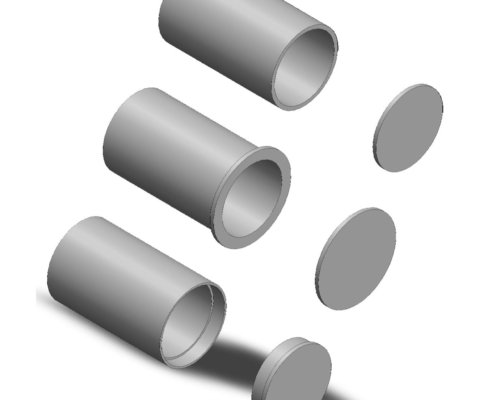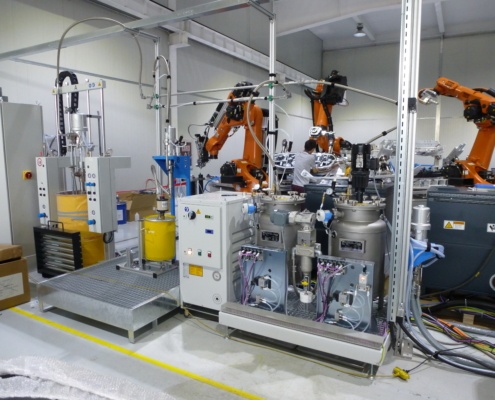… does not only mean to identify from the almost infinite number of adhesives offered by the various manufacturers – for Europe alone this is estimated at about 35,000 – the “right one”. It is quite important to consider the entire process from component design to possible reworking, also from a commercial point of view.
I am happy to support you in this.
Design suitable for bonding
As with all joining processes, the part design must be adapted to the respective joining process, i.e. it must be suitable for bonding. It is therefore important to ensure that, in addition to providing a sufficiently large bonding surface, the occurrence of peel or cleavage loads is avoided, i.e. that occurring forces should be transmitted over as large an area as possible by tension, pressure, shear or torsion.
Elaboration of the list of requirements
With my structured approach, which starts with the elaboration of the list of requirements for the finished part and in particular for the bond, this is not a piece of witchcraft
Already at this point it is a good idea to carry out the classification of the bond required by DIN 2304-1 – Adhesive bonding technology – Quality requirements for adhesive bonding processes with regard to the potential effects of a pontential failure.
The requirements profile for the adhesive is then derived from the requirements determined for the finished part, taking into account the materials to be bonded together. Additional requirements, such as those resulting from the expected quantities and the conditions at the production site, are also taken into account. Of course, commercial requirements must also be taken into account at this point.
The requirement profile distinguishes between the criteria that must be “absolutely fulfilled” and those that would only be “nice to have”. This avoids the effort being pushed too high, which in the worst case would lead to a solution that is either too expensive or not practicable at all – the “jack of all trades adhesive” does not exist.
Adhesive selection
Based on their properties one to two or at most three suitable adhesive technologies usually crystallize from the requirement profile created in this way. These are explained to the client against the background of the specific application, taking into account the specific advantages and disadvantages, and are finally prioritized in the subsequent discussion. It is quite possible that a technology initially regarded as promising may be discarded.
In the next step, manufacturers of adhesives for the selected technologies will be targeted. My market knowledge and especially my good personal contacts in the adhesives industry have proven to be very helpful.
The technical data sheets provided by the manufacturers for their adhesives differ considerably from supplier to supplier. This applies not only to the amount of data, but also to the methods used to determine them. Thus a direct comparison is not always possible and requires appropriate technical knowledge in order to select potentially promising candidates for initial tests.
Testing of selected adhesive candidates
The selection of the tests to be carried out within the framework of initial comparative tests is made on the basis of the mechanical, thermal, media and other loads identified for the bonds and taking into account the parts currently available. Initial tests can be carried out on standardized test specimens, but tests can also be carried out already on real parts. If necessary, different methods for surface treatment and first accelerated ageing tests will be included.
In the ideal case, two to three adhesives already crystallize as promising, which are then subjected to further application-oriented tests in accordance with the requirement profile drawn up. The aim of these tests is to provide the proof required by DIN 2304-1 that the strength of the bond over the entire product life is always greater than the loads actually occurring.
Determination of the bonding process
Regardless of whether it is a manual low or a fully automated high volume production, in addition to the actual bonding process, i.e. adhesive application, joining and adhesive curing, the upstream and downstream process steps must also be aligned to the respective adhesive.
Validation
The final step is the validation of the entire bonding process with parts produced under series conditions.
Determination of the quality assurance measures accompanying production
Even though significant progress has been made in non-destructive testing of bonded joints by improving existing methods and developing new ones, it is still not possible to check the quality of bonded joints completely non-destructively, which by the way also applies to welded joints. Destructive methods are always required for this, so a 100% inspection is not feasible on its own. Instead, the quality-compliant execution of the bond can be ensured by a reasonable combination of organizational measures and production-accompanying tests, with a minimum expenditure of destructive tests on components.
The necessary organizational requirements based on DIN EN ISO 9001 and the DIN 2304-1 standard that concretizes this standard are described elsewhere (Implementation of DIN 2304-1. Downloads: “New DIN 2304 Standard and it‘s use in Practice“, “The New DIN 2304-1 Standard – The Way to a Zero Defect Bonding Process“)
In addition, a test program adapted to the respective application and accompanying production, with good documentation of the results, offers additional safety. This starts with the incoming goods inspection, whereby this must not be limited to the adhesive used, but should also include the adhesive-relevant properties of the parts to be joined and the process materials used. An in-line inspection of important process parameters offers additional safety. In addition, random checks on work samples or finished components produced during production can be useful.




